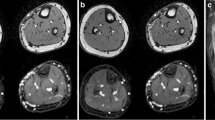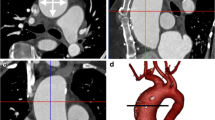Abstract
Vascular diseases today constitute a serious health burden, ranking atherosclerosis as number one in the morbidity and mortality statistics of developed countries, with a still-growing incidence. Different treatment options are available for all vascular territories, ranging from conservative pharmacological treatment and catheter-based interventions up to surgical methods with remodelling of the vessels or bypass implantation. For treatment planning, all listed procedures have in common that they rely on initial diagnostic imaging to assess the degree and extent of stenoses. In this respect, imaging of the arterial system from the head down to the feet seems to be reasonable. Up to now no imaging technique allowed the assessment of the complete arterial system in only one exam within a reasonable time and without limiting factors like invasiveness and ionizing radiation. However, recent developments in magnetic resonance (MR) hardware and software, such as dedicated whole-body MR systems with specially designed surface coils, the movement to higher field strength and the implementation of parallel acquisition techniques (PAT), have helped to overcome the long-standing limitations of MR angiography (MRA), like reduced spatial resolution, long acquisition time, the restriction to body parts and only one field of view of a maximum 50 cm.






Similar content being viewed by others
References
Diehm C, Kareem S, Lawall H (2004) Epidemiology of peripheral arterial disease. Vasa 33(4):183–189
Uzu T et al (2002) Prevalence and outcome of renal artery stenosis in atherosclerotic patients with renal dysfunction. Hypertens Res 25(4):537–542
Adams MR, Celermajer DS (1999) Detection of presymptomatic atherosclerosis: a current perspective. Clin Sci (Lond) 97(5):615–624
Vasbinder GB et al (2004) Accuracy of computed tomographic angiography and magnetic resonance angiography for diagnosing renal artery stenosis. Ann Intern Med 141(9):674–682
Carroll TJ et al (2001) Carotid bifurcation: evaluation of time-resolved three-dimensional contrast-enhanced MR angiography. Radiology 220(2):525–532
Ekelund L et al (1996) MR angiography of abdominal and peripheral arteries. Techniques and clinical applications. Acta Radiol 37(1):3–13
Huston J 3rd et al (2001) Carotid artery: elliptic centric contrast-enhanced MR angiography compared with conventional angiography. Radiology 218(1):138–143
Leiner T et al (2005) Magnetic resonance imaging of atherosclerosis. Eur Radiol 15(6):1087–1099
Meaney JF (1999) Non-invasive evaluation of the visceral arteries with magnetic resonance angiography. Eur Radiol 9(7):1267–1276
Meaney JF, Sheehy N (2005) MR angiography of the peripheral arteries. Magn Reson Imaging Clin N Am 13(1):91–111, vi
Meissner OA et al (2005) Critical limb ischemia: hybrid MR angiography compared with DSA. Radiology 235(1):308–318
Steffens JC et al (1999) Lower extremity occlusive disease: diagnostic imaging with a combination of cardiac-gated 2D phase-contrast and cardiac-gated 2D time-of-flight MRA. J Comput Assist Tomogr 23(1):7–12
Fenchel M et al (2006) Atherosclerotic disease: whole-body cardiovascular imaging with MR system with 32 receiver channels and total-body surface coil technology–initial clinical results. Radiology 238(1):280–291
Goyen M et al (2003) Detection of atherosclerosis: systemic imaging for systemic disease with whole-body three-dimensional MR angiography–initial experience. Radiology 227(1):277–282
Goyen M et al (2003) Using a 1 M Gd-chelate (gadobutrol) for total-body three-dimensional MR angiography: preliminary experience. J Magn Reson Imaging 17(5):565–571
Goyen M et al (2003) Whole-body three-dimensional MR angiography with a rolling table platform: initial clinical experience. Radiology 224(1):270–277
Kramer H et al (2005) Cardiovascular screening with parallel imaging techniques and a whole-body MR imager. Radiology 236(1):300–310
Baumgartner I, Schainfeld R, Graziani L (2005) Management of peripheral vascular disease. Annu Rev Med 56:249–272
Cahan MA et al (1999) The prevalence of carotid artery stenosis in patients undergoing aortic reconstruction. Am J Surg 178(3):194–196
Dormandy J, Heeck L, Vig S (1999) The natural history of claudication: risk to life and limb. Semin Vasc Surg 12(2):123–137
Dormandy J, Heeck L, Vig S (1999) Lower-extremity arteriosclerosis as a reflection of a systemic process: implications for concomitant coronary and carotid disease. Semin Vasc Surg 12(2):118–122
Cortell ED et al (1996) MR angiography of tibial runoff vessels: imaging with the head coil compared with conventional arteriography. AJR Am J Roentgenol 167(1):147–151
Fellner FA et al (2003) Peripheral vessels: MR angiography with dedicated phased-array coil with large-field-of-view adapter feasibility study. Radiology 228(1):284–289
Ho KY et al (1998) Peripheral vascular tree stenoses: evaluation with moving-bed infusion-tracking MR angiography. Radiology 206(3):683–692
Meaney JF et al (1999) Stepping-table gadolinium-enhanced digital subtraction MR angiography of the aorta and lower extremity arteries: preliminary experience. Radiology 211(1):59–67
Ruehm SG et al (2000) Pelvic and lower extremity arterial imaging: diagnostic performance of three-dimensional contrast-enhanced MR angiography. AJR Am J Roentgenol 174(4):1127–1135
Wang Y et al (1998) Bolus-chase MR digital subtraction angiography in the lower extremity. Radiology 207(1):263–269
Busch HP et al (2001) [MR angiography of pelvic and leg vessels with automatic table movement technique (“Mobi-Trak”)–clinical experience with 450 studies]. Rofo 173(5):405–409
Goyen M et al (2001) Improved multi-station peripheral MR angiography with a dedicated vascular coil. J Magn Reson Imaging 13(3):475–480
Ho KY et al (1999) Peripheral MR angiography. Eur Radiol 9(9):1765–1774
Leiner T et al (2000) Three-dimensional contrast-enhanced moving-bed infusion-tracking (MoBI-track) peripheral MR angiography with flexible choice of imaging parameters for each field of view. J Magn Reson Imaging 11(4):368–377
Huber A et al (2003) Moving-table MR angiography of the peripheral runoff vessels: comparison of body coil and dedicated phased array coil systems. AJR Am J Roentgenol 180(5):1365–1373
Leiner T et al (2004) Use of a three-station phased array coil to improve peripheral contrast-enhanced magnetic resonance angiography. J Magn Reson Imaging 20(3):417–425
Ruehm SG et al (2001) Rapid magnetic resonance angiography for detection of atherosclerosis. Lancet 357(9262):1086–1091
Shetty AN et al (2002) Lower extremity MR angiography: universal retrofitting of high-field-strength systems with stepping kinematic imaging platforms initial experience. Radiology 222(1):284–291
Ruehm SG et al (2000) [Whole-body MRA on a rolling table platform (AngioSURF)]. Rofo 172(8):670–674
Winterer JT et al (2003) Background suppression using magnetization preparation for contrast-enhanced 3D MR angiography of the pelvic and lower leg arteries. Rofo 175(1):28–31
Herborn CU et al (2003) Whole-body 3D MR angiography of patients with peripheral arterial occlusive disease. AJR Am J Roentgenol 182(6):1427–1434
Quick HH et al (2004) High spatial resolution whole-body MR angiography featuring parallel imaging: initial experience. Rofo 176(2):163–169
Ghanem N et al (2004) [Whole-body MRI in comparison to skeletal scintigraphy for detection of skeletal metastases in patients with solid tumors]. Radiologe 44(9):864–873
Lauenstein TC et al (2002) Whole-body MRI using a rolling table platform for the detection of bone metastases. Eur Radiol 12(8):2091–2099
Lauenstein TC et al (2004) Whole-body MR imaging: evaluation of patients for metastases. Radiology 233(1):139–148
Lauenstein TC et al (2002) Three-dimensional volumetric interpolated breath-hold MR imaging for whole-body tumor staging in less than 15 minutes: a feasibility study. AJR Am J Roentgenol 179(2):445–449
Goehde SC et al (2005) Full-body cardiovascular and tumor MRI for early detection of disease: feasibility and initial experience in 298 subjects. AJR Am J Roentgenol 184(2):598–611
Ruehm SG, Goehde SC, Goyen M (2004) Whole body MR angiography screening. Int J Cardiovasc Imaging 20(6):587–591
Fenchel M et al (2005) Whole-body MR angiography using a novel 32-receiving-channel MR system with surface coil technology: first clinical experience. J Magn Reson Imaging 21(5):596–603
Nael K et al (2007) High-spatial-resolution whole-body MR angiography with high-acceleration parallel acquisition and 32-channel 3.0-T unit: initial experience. Radiology 242(3):865–872
Born M et al (2007) Sensitivity encoding (SENSE) for contrast-enhanced 3D MR angiography of the abdominal arteries. J Magn Reson Imaging 22(4):559–565
Fain SB et al (1999) Theoretical limits of spatial resolution in elliptical-centric contrast-enhanced 3D-MRA. Magn Reson Med 42(6):1106–1116
Griswold MA et al (2002) Generalized autocalibrating partially parallel acquisitions (GRAPPA). Magn Reson Med 47(6):1202–1210
Jakob PM et al (1998) AUTO-SMASH: a self-calibrating technique for SMASH imaging. SiMultaneous Acquisition of Spatial Harmonics. Magma 7(1):42–54
Kramer H et al (2004) [Cardiovascular whole body MRI with parallel imaging]. Radiologe 44(9):835–843
McKenzie CA et al (2004) Shortening MR image acquisition time for volumetric interpolated breath-hold examination with a recently developed parallel imaging reconstruction technique: clinical feasibility. Radiology 230(2):589–594
Pruessmann KP et al (1999) SENSE: sensitivity encoding for fast MRI. Magn Reson Med 42(5):952–962
Kruger DG et al (2002) Continuously moving table data acquisition method for long FOV contrast-enhanced MRA and whole-body MRI. Magn Reson Med 47(2):224–231
Fain SB et al (2004) Floating table isotropic projection (FLIPR) acquisition: a time-resolved 3D method for extended field-of-view MRI during continuous table motion. Magn Reson Med 52(5):1093–1102
Kruger DG et al (2005) Dual-velocity continuously moving table acquisition for contrast-enhanced peripheral magnetic resonance angiography. Magn Reson Med 53(1):110–117
Madhuranthakam AJ et al (2004) Time-resolved 3D contrast-enhanced MRA of an extended FOV using continuous table motion. Magn Reson Med 51(3):568–576
Zhu Y, Dumoulin CL (2003) Extended field-of-view imaging with table translation and frequency sweeping. Magn Reson Med 49(6):1106–1112
Zenge MO et al (2006) High-resolution continuously acquired peripheral MR angiography featuring partial parallel imaging GRAPPA. Magn Reson Med 56(4):859–865
Tombach B (2004) Whole-body CE-MRA with Gadovist. Eur Radiol 14(Suppl 5):M26–M27.62
Goyen M et al (2002) Optimization of contrast dosage for gadobenate dimeglumine-enhanced high-resolution whole-body 3D magnetic resonance angiography. Invest Radiol 37(5):263–268
Bilecen D et al (2004) MR angiography with venous compression. Radiology 233(2):617–618; author reply 618–619
Zhang HL et al (2004) Decreased venous contamination on 3D gadolinium-enhanced bolus chase peripheral mr angiography using thigh compression. AJR Am J Roentgenol 183(4):1041–1047
Herborn CU (2004) Peripheral contrast-enhanced 3D MRA with 1.0 M gadobutrol. Eur Radiol 14(Suppl 5):M23–M25
Kramer H et al (2007) High-resolution magnetic resonance angiography of the lower extremities with a dedicated 36-element matrix coil at 3 Tesla. Invest Radiol 42(6):477–483
Leiner T et al (2005) Peripheral arterial disease: comparison of color duplex US and contrast-enhanced MR angiography for diagnosis. Radiology 235(2):699–708
Fink C et al (2007) Magnetic resonance imaging of acute pulmonary embolism. Eur Radiol 17(10):2546–2553
Lin J et al (2006) Whole-body three-dimensional contrast-enhanced magnetic resonance (MR) angiography with parallel imaging techniques on a multichannel MR system for the detection of various systemic arterial diseases. Heart Vessels 21(6):395–398
Author information
Authors and Affiliations
Corresponding authors
Additional information
H. Kramer and H.H. Quick contributed equally to the preparation of this manuscript and share first authorship
Rights and permissions
About this article
Cite this article
Kramer, H., Quick, H.H., Tombach, B. et al. Whole-Body MRA. Eur Radiol 18, 1925–1936 (2008). https://doi.org/10.1007/s00330-007-0817-5
Received:
Revised:
Accepted:
Published:
Issue Date:
DOI: https://doi.org/10.1007/s00330-007-0817-5




